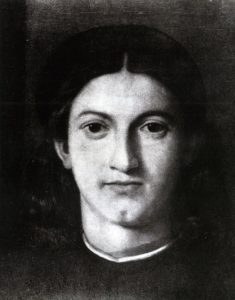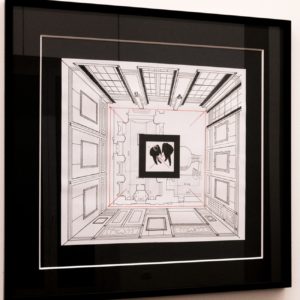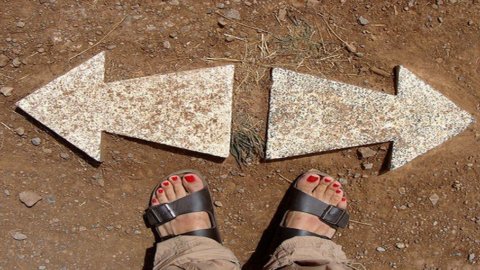Among the protagonists of the movement of Arte Povera, Giulio Paolini (Genoa 1940) is dedicated to analytical research with a strong conceptual imprint that leads him to cancel any external value to the concept and definition of art. From his first work, Geometric drawing (1960), made when she was only twenty “ – a canvas painted in tempera, on which he traces, without adding anything else, the squaring of the surface, a preliminary procedure for any possible representation – Giulio Paolini has developed his research by investigating the constituent elements of the painting, the space of representation, the phenomenon of seeing and the figure of the author. “Over time – explains Maddalena Disc in an essay on Paolini's artistic research published on the artist's official website – the focus on the work considered in its evolution – in search of its own possibility of definition – led him to focus his attention increasingly on the gesture of the exhibition , to the point of bringing into play the legitimacy or necessity of this self-showing. His works have "nothing to declare": they do not want to communicate anything, limiting themselves to evoking the premises of their manifestation. Mainly made up of blank canvases, drawing sheets, plaster casts, photographic reproductions, Plexiglas volumes and a vast repertoire of iconographic elements (from details of ancient paintings to fragments of sidereal visions), they stage the expectation of a image that eludes any attempt at fixation, to remain suspended in the potential dimension. The constant postponement of the moment of revelation leaves room for the interrogation of representation as such: for the scaffolding that announces it, for the catalog of hypotheses that precedes it and for the mystery that precludes it from immediate gaze"

Young man looking at Lorenzo Lotto, 1967
Photo on emulsified canvas 30×24 cm.
In “Young man looking at Lorenzo Lotto” – a photo of a few centimeters (30×24) on emulsified canvas from 1967 which reproduces in black and white the portrait of a young man painted by Lorenzo Lotto in 1505 – Paolini triggers a game of imaginary gazes with the sixteenth-century master. If the anonymous boy is looking at Lorenzo Lotto, it means that the spectator becomes Lorenzo Lotto. And he puts himself in the painter's shoes, takes up the challenge of that aimed at capturing its secret, at catching a whiff of identity. “The works look at us. They are the ones who look at us and not vice versa. The work does not speak but sees, it sees us at the very moment in which we think we see it”, explains the artist. In the most recent research, attention is focused in particular on the identity of the author: on his "abstinence" from the pre-existence of the work. "The more it is recognized as Absolute - indifferent to any possibility of appropriation or representation - the more - writes Maddalena again Disc – he declares himself extraneous to his conception. Art happens without the artist's knowledge: his conception is immaculate and the enigma of his becoming remains unfathomable. The renunciation of authorship, which already in Geometric drawing announced itself as a "vow of chastity", attested without repentance in later works, it is declared in unequivocal terms in works such as Immaculate Conception (Untitled / Without author) (2008) and Happy suicide (2010). Thanks to the sacrifice of himself, in favor of the exclusive voice of the work, the author can finally enjoy the only privilege due to him: that of presiding over the inviolability of the work of art. The only prerogative that he will never be able to give up is in fact the urgency that always moves him to set up a reserved area, a private room, sheltered from the world, where in the "hour X" the work can reveal itself in the its authenticity".

Study for “Da-far” 2015
Photo Pierangelo Parimbelli-
Giulio Paolini
Born November 5, 1940 in Genoa, lives and works in Turin. He is one of the founders of the Arte Povera movement, initiated by the critic Germano CelantHis exhibition activity is intense. Since his first solo show in 1964 he has had countless exhibitions in galleries and museums around the world. Among the major anthologies by him are those at the Palazzo della pilot in Parma (1976), allo Urban Museum of Amsterdam (1980), al New Museum di Villeurbanne (1984), at State Gallery in Stuttgart (1986), at the National Gallery of Modern Art in Rome (1988), at New Gallery am State Museum Joanneum of Graz (1998), at the Prada Foundation in Milan (2003), al Art museum by Winterthur (2005) et al Whitechapel Gallery in London (2014). He has participated in various exhibitions of Arte Povera and has been invited several times to the Documenta di Kassel (1972, 1977, 1982, 1992) and 10 times at the Venice Biennale (1970, 1976, 1978, 1980, 1984, 1986, 1993, 1995, 1997, 2013). His work is present in numerous museums in Italy and abroad and in important international public and private collections. Graphic designer by training, he has always nurtured a particular interest in the publishing field and the written page. From the very beginning he has accompanied his artistic research with reflections collected in personally edited books: da Idem, published in 1975 by Einaudi (Turin) with an introduction by Italo Calvino, a Four steps. In the museum without muses, released in 2006 by the same publisher, e The author who thought he existed, published by Johan & Levi (Milan) in 2012. Since 1969 he has also created sets and costumes for theatrical performances, among which the projects conceived with Carlo Quartucci in the XNUMXs and the recent sets for two operas by Richard Wagner for direction of Frederick Tiezzi (2005, 2007).
The market
After an adjustment phase that began around 2014 (common to many great Italian and non-Italian masters), starting from the second half of 2017 the artist's prices are clearly recovering on the international market. To testify to the interest in his work, over 650 auctions with a percentage of sales exceeding 80% (over 55% abroad) and a turnover that in 2017 came close to 700 thousand euros. According to the index "Artprice”, one hundred euros invested in a work by Paolini in 2000, in January 2018 they were worth on average almost 430 euros.
Gallery: In Italy Paolini is treated by Alfonso Artiacus of Naples, Fumagalli, Christian Stein, and Marconi of Milan, Tucci Tower Russian pinch (That's it). Abroad he works with Gallery MehdiChouakri in Berlin , Marian Goodman Gallery in New York and Gallery Yvon Lambert in Paris.
Pricing: In the gallery, to buy one of his "historic" works (from the 60s to the early 70s) you start from around 200 euros up to and even exceeding one million for large installations. The prices of recent productions are more contained: from 15 to 20 thousand euros for the papers and collages, to 50-80 thousand euros for the sculptures and its characteristic assemblages. For installations dated between the 80s and 90s you can spend from 80 to 100 thousand euros up to even exceeding 300 thousand euros, depending on the quality, complexity and size of the work.
Top Price at auction: "Index of works inscribed in a decorative motif" , acrylic and graphite on canvas, 200 cm x 300,3 cm., made in 1972, changed hands from Christie'sin New York in November of 2015 a 586.228 euros (rights included) quadrupling the estimate. Also from Christie's in the big one apple, a few months later, in May 2016, “Notes for the Description of a Painting dated 1972 “ , a mixed technique on canvas of 199,3 x 300,3 cm. it was sold for 532 thousand euros, starting from an estimate of less than 100 thousand euros.
Cover image:
Giulio Paolini – The art and the space. Four illustrations for a paper by Martin Heidegger, 1983. – Photo Pierangelo Parimbelli – Coutesy Fumagalli Gallery





